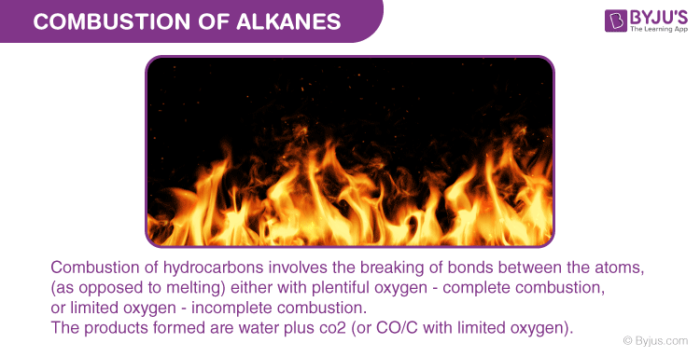
Table of Contents
Let us first understand the terms combustion and alkanes individually then move towards the topic. Combustion or burning is a high temperature exothermic reaction. It happens between a fuel and oxygen (oxidant), giving out gaseous products, also termed as smoke. Alkane is referred to as a saturated open chain hydrocarbon consisting of carbon-carbon single bonds.
Combustion of alkanes:
- Complete combustion of alkanes: When alkane is heated in the presence of sufficient air or dioxygen it forms carbon dioxide and water and an enormous amount of heat energy is released. For example:
CH4 (g) + 2O2 (g) → CO2 (g) + 2H2O (l); ∆cHΘ = – 890 kJ mol-1
C4H10 + 13/2 O2(g) → 4CO2 (g) + 5H2O (l); ∆cHΘ = – 2875.84 kJ mol-1
The above reaction can be generalised as follows:
CnH2n+2 + ((3n+1)/2) O2 → nCO2 + (n+1) H2O
Alkanes can also be used as a fuel, as they produce large amounts of heat.
- Incomplete combustion of alkanes: It occurs when there is not enough amount of oxygen for fuel to react completely. This leads to the formation of carbon or carbon monoxide. Carbon monoxide formed as a by-product is a colourless poisonous gas. For example:
The carbon black produced during the incomplete burning of alkane is used in the manufacturing of inks.
Trends in combustion:
For a hydrocarbon, if complete ignition occurs then it burns with a blue flame. As the molecular mass of hydrocarbon increases it starts burning with a yellow coloured flame showing incomplete burning. The burning of hydrocarbons becomes difficult with increasing molecular weights.
Know more about Pyrolysis of Alkanes

Comments